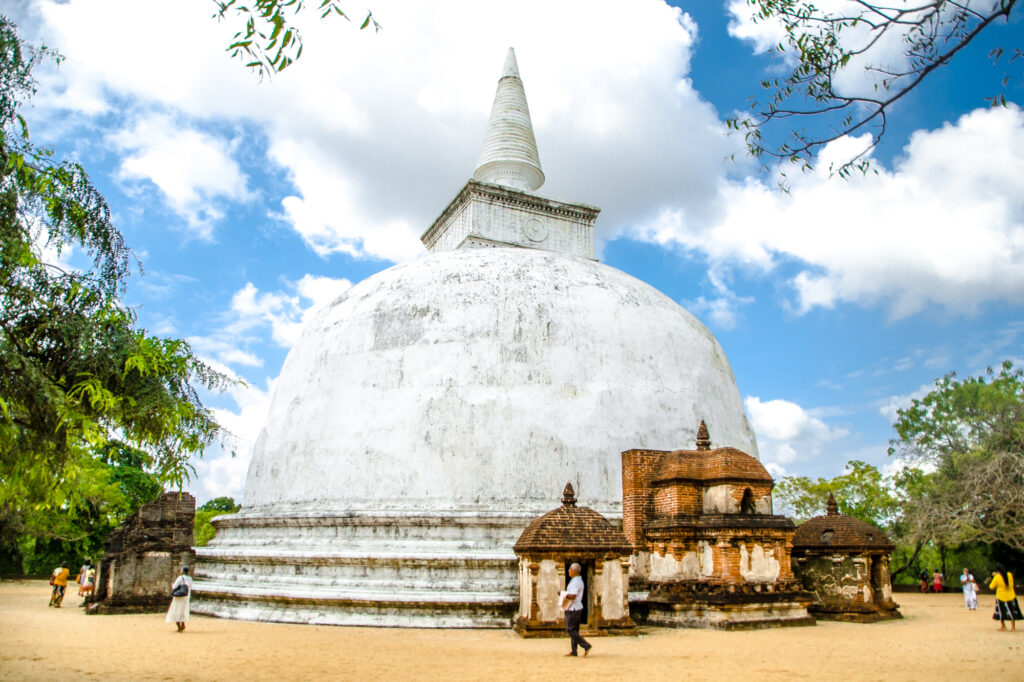Disclosure: This post contains affiliate links that I may earn a small commission from if you purchase something through them. This comes at no extra cost to you!
In the heart of Sri Lanka quietly rests the remains of Polonnaruwa, an ancient city with significant importance.
This cultural site was the second capital of Sri Lanka and is therefore the second most ancient city in the country after Anuradhapura. It’s part of the famous cultural triangle (made up of Sigiriya, Polonnaruwa and Anuradhapura) and is packed full of ancient structures including towering monuments, Royal Palaces, ruined temples and religious shrines.
Once the centre of a thriving empire, Polonnaruwa gave me major Angkor Wat vibes, albeit on a slightly smaller scale. The temples are amazingly well preserved considering they are some of the oldest in the country, and all can be seen in a few hours. In this guide I’ll explain everything you need to know before a visit to Polonnaruwa, from how to get around, the best places to see and what to expect from this gem while you’re there.
Table of Contents...
Toggle
Useful information for Polonnaruwa
- Country: Sri Lanka
- Language: Sinhala, Tamil and English
- Population: 400,000 (current Polonnaruwa District)
- Currency: £1/$1 = 400/320 LKR (Sri Lanka Rupees)
- Visa info: Visitors are required to get an ETA before arriving in Sri Lanka. This can be applied for here and costs about $30. Tourist visas are usually valid for 30 days.
- SIM cards: For the best coverage across Sri Lanka I recommend picking up an affordable SIM card from Mobitel when you arrive, which is what I did. Another option is to get an eSIM onlinewhich you can do here.
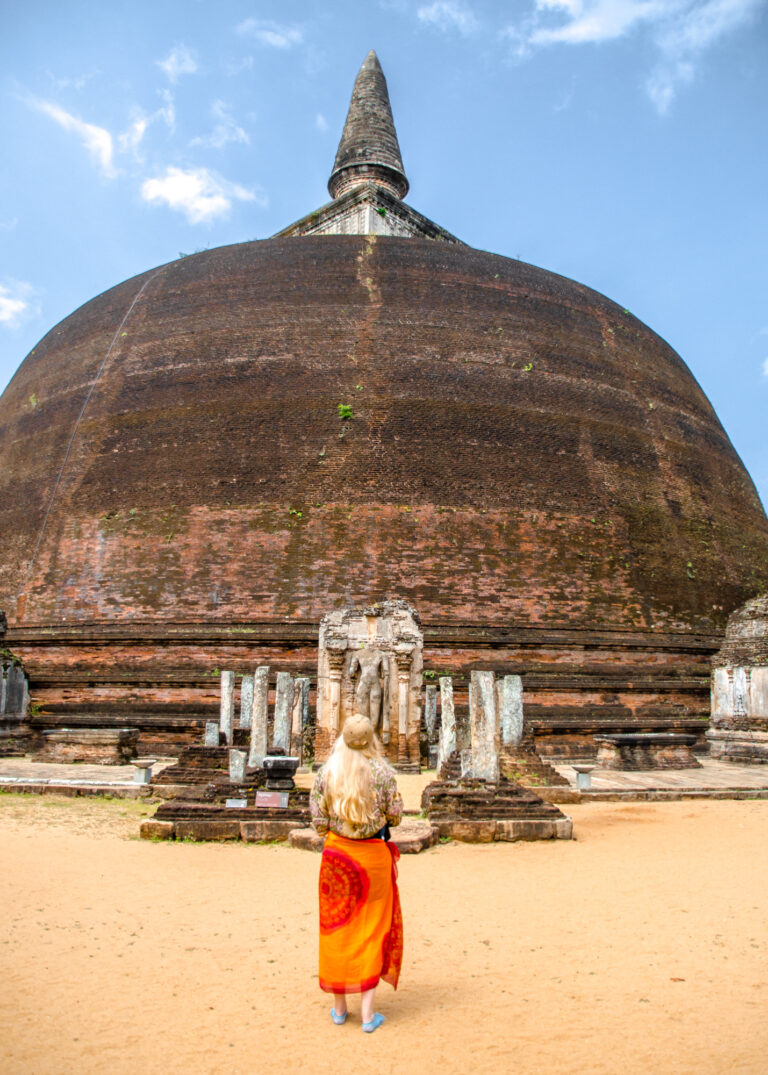
A brief history of Polonnaruwa
Polonnaruwa became the second capital of Sri Lanka in 993 A.D. after the destruction of the Sinhalese Kingdom of Anuradhapura which had stood for 1400 years.
Polonnaruwa was chosen for its ts strategic location overlooking a river crossing and remained the capital for three centuries. Many kings ruled Polonnaruwa, but King Parakramabahu (1153-1186) was the most notable. He unified Sri Lanka and built magnificent temples, palaces and pools to expand the city, as well as an intricate irrigation system that is amazingly still in use today.
Eventually, in 1310, the city was abandoned after rulers continued building without raising the funds to support the expansions, nearly bankrupting the kingdom and leading people to flee.
The ancient city became a UNESCO World Heritage Site in 1982 and attracts thousands of visitors every year.
Where is Polonnaruwa
Polonnaruwa is located in central Sri Lanka and is roughly 2 hours away from Sigiriya by road and around 4 hours from Kandy. It is 228km from Colombo, Sri Lanka’s capital, and that particular journey takes about 4.5 hours by road.
Check out the location on the interactive map below
Getting around
You have four main options to get around Polonnaruwa.
- Bicycle: For freedom, fun and affordability, hire a bicycle and cycle around Polonnarruwa yourself. Oftentimes I find going slower in locations like this allows you to discover places you would otherwise never have found, so this is the option I’d recommend if you can cope with the humidity. Allow 5 hours to explore Polonarruwa by bike and expect it to cost $3 for the day.
- Hire a tuktuk and driver: Hiring a tuktuk driver to take you around the ancient city is a fun way to explore as well. You’ll sacrifice air-conditioning for open-air vibes and overall it’s a cool and convenient way to travel if you don’t want to plot a route around the city independently. Note that most drivers do not double as tour guides, so if you want a guide keep reading the other options below. Expect to pay up to $10 USD to be taken to the highlights of the city by tuktuk.
- Tuktuk tour: Booking a Polonnaruwa Tuk-Tuk Tour is a fantastic way to see the city. It’s like a merge between hiring a tuktuk driver and a small group tour, with the private 4 hour experience offering an intimate and information-filled option. It does, however, fall on the pricier side of the spectrum, costing around $75 for the duration.
- Guided tour: Small group tours with GetYourGuide or Viator are a fantastic way to see the sights of any given area efficiently and with a knowledgeable guide. Tours include an English speaking guide, air conditioned vehicle and entrance fees. This is a great way to learn about Polonnaruwa from an expert while meeting fellow like-minded travellers at the same time. You can even catch a tour all the way from Colombo, Sri Lanka’s capital city, that will last 10-12 hours if you’re pushed for time. Check it out here: Day Trip to the Ancient Capital of Polonnaruwa From Colombo
Expected costs
The entrance fee for Polonnaruwa is $25 USD per person. For visitors from SAARC countries a 50% discount applies and for Sri Lankan locals it’s free.
How much time to allow
This depends on which mode of transport you use to get around the area, but as an absolute minimum I think you need to spend at least 4 hours here to do the historic site any form of justice.
I’d recommend staying until you’ve seen every location in this itinerary. That could be 5-6 hours on a bicycle or 4 hours on a tour but it really depends. Any shorter, no matter the form of transport, is not long enough to see everything in any real depth.
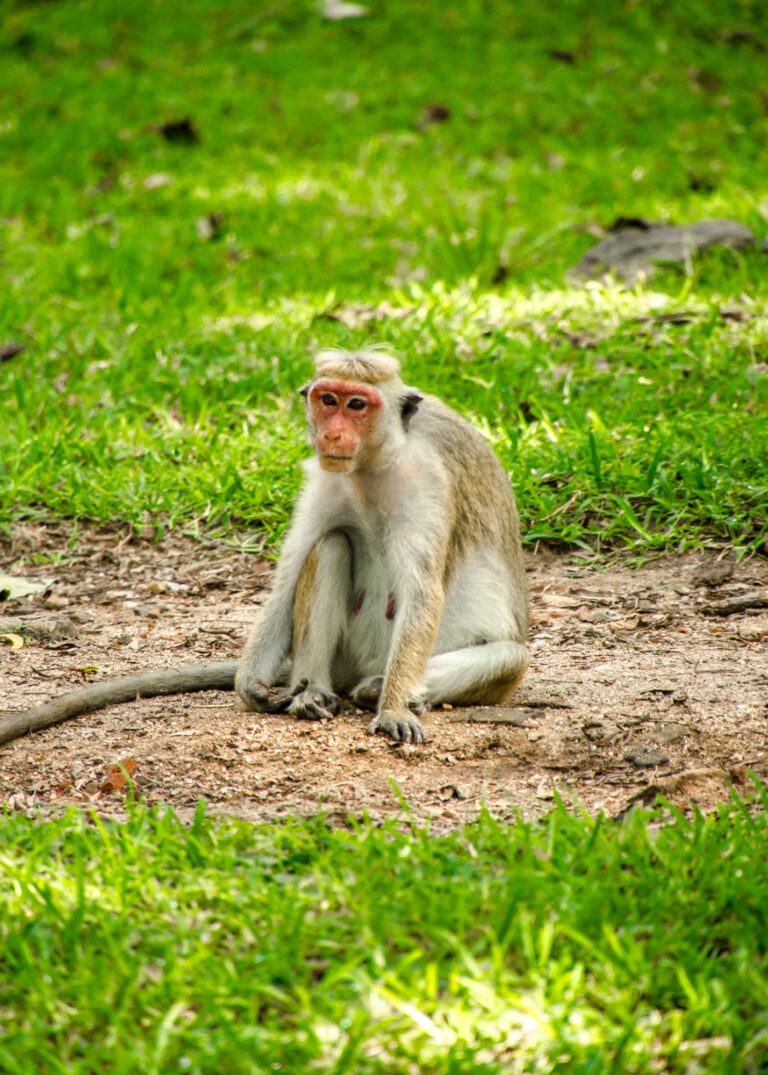
The 8 best sights of Polonnaruwa Ancient City
Polonnaruwa is packed with popular sites, but one of the great things about the area is just how many hidden gems you’ll accidentally find along the way. Getting lost and exploring the places where there are no crowds is a huge part of the fun here!
So, as much as you should visit everything on this travel guide, I employ you to make a point of exploring off the beaten path while you’re there as well.
The Royal Palace
Once the residence of King Parakramabahu who reigned from 1153 to 1186, the Royal Palace is assumed to have been an impressive seven-stories tall before it’s collapse.
Nowadays, you’ve got to use your imagination to envision the actual palace, but within its grounds there are some cool sights to see, not to mention the epic pillars that remain.
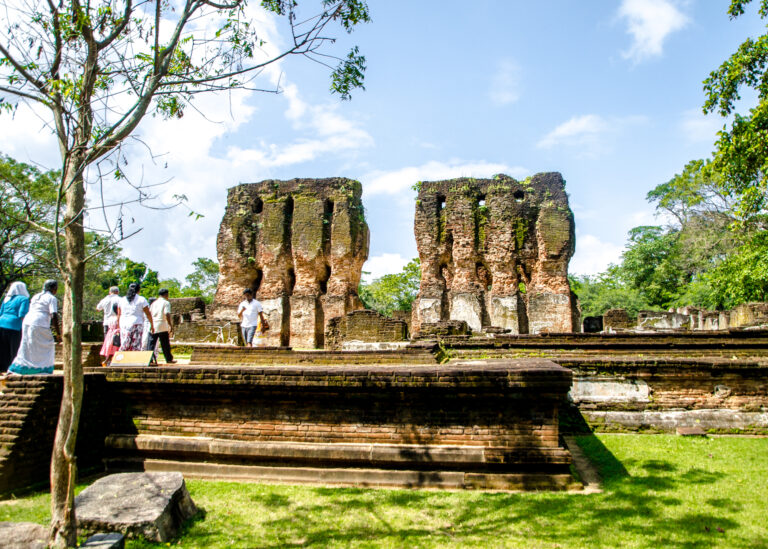
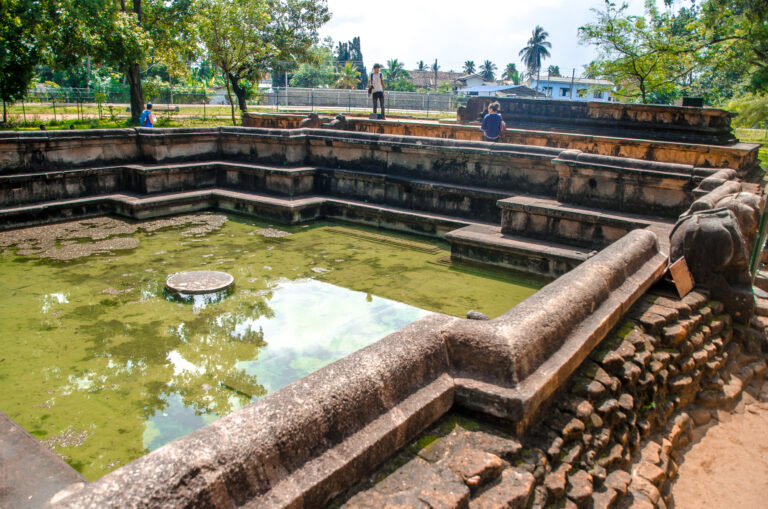
The King’s Bathing Pool is a notable stop, which is decorated with crocodile fountains and a central lotus island. The murky green waters presumably looked more inviting back in the day, but it’s an important site nonetheless.
Another cool place to see here is the Audience Chamber, where you’ll find 48 stone pillars in 4 symmetrical rows. There’s a lion carved into stone where the throne would have been and the outer walls of the hall are decorated with carvings of elephants, lions and mythical creatures.
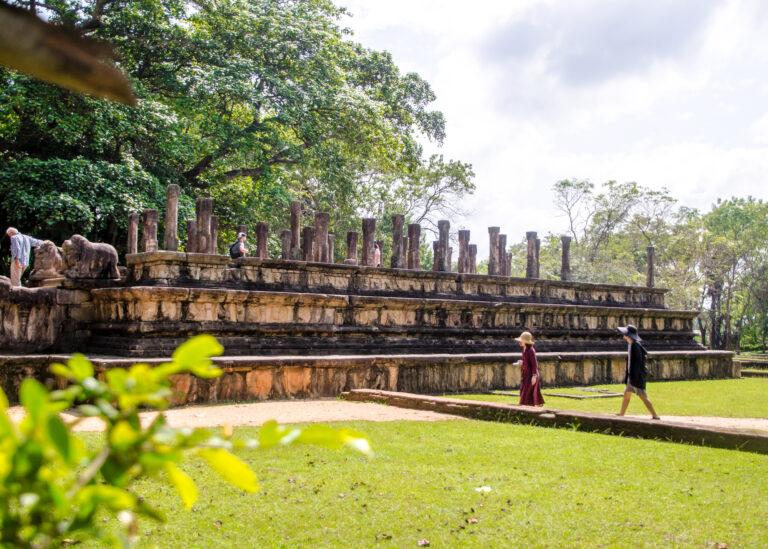
The Sacred Quadrangle
This is one of the ancient city’s most known features and a very sacred place where the most concentrated cluster of buildings in Polonnaruwa are found.
Also known as Dalada Maluwa (the Terrace of the Tooth Relic), the Quadrangle is home to many epic structures, but the most iconic place is the Vatadage. The Vatadage is a twin-tiered relic house and one of Polonnaruwa’s most iconic landmarks.
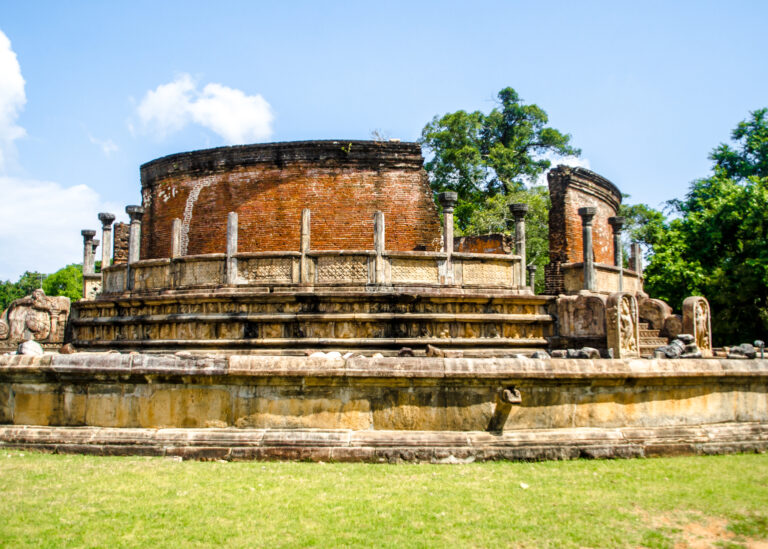
Climb the short set of stairs to enter the terrace and explore the cluster of ruins inside. The Buddha Tooth Relic used to be housed here until it was relocated to Kandy.
Nowadays you can view elaborate stone carvings and intricate designs throughout the structure, with all four entrances leading to a central stupa and four Buddhas.
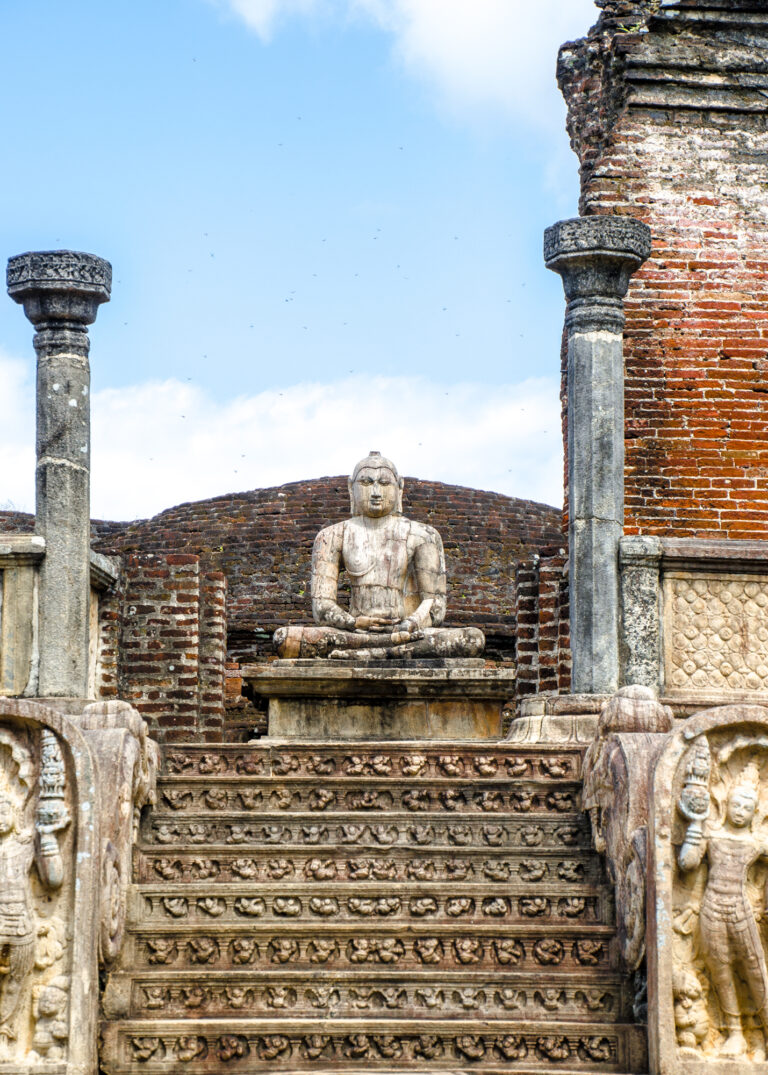
Rankoth Vihara
In the heart of the ancient city lies a mighty 54 metre tall stupa dominating the area.
Rankoth Vihara is the largest dagoba in Polonnaruwa and the 4th largest in the whole country. It was built during the reign of King Nissanka Malla and is made entirely of brick, with the reddish appearance giving it a unique colour pop.
It remains one of the most intact and well preserved stupas in the whole archeological zone.

Lankatilaka
The mighty standing Buddha statue at Lankatilaka is an impressive sight to behold, that’s for sure!
Surrounded by 17 metre high walls, the headless Buddha statue stands tall at the end of a cathedral-like corridor. Despite only the body remaining today, the statue was once a whopping 13 metres tall and is a highlight for many who visit Polonnaruwa.
Visit early in the day to get the corridor all to yourself and shoot that Insta-banger!
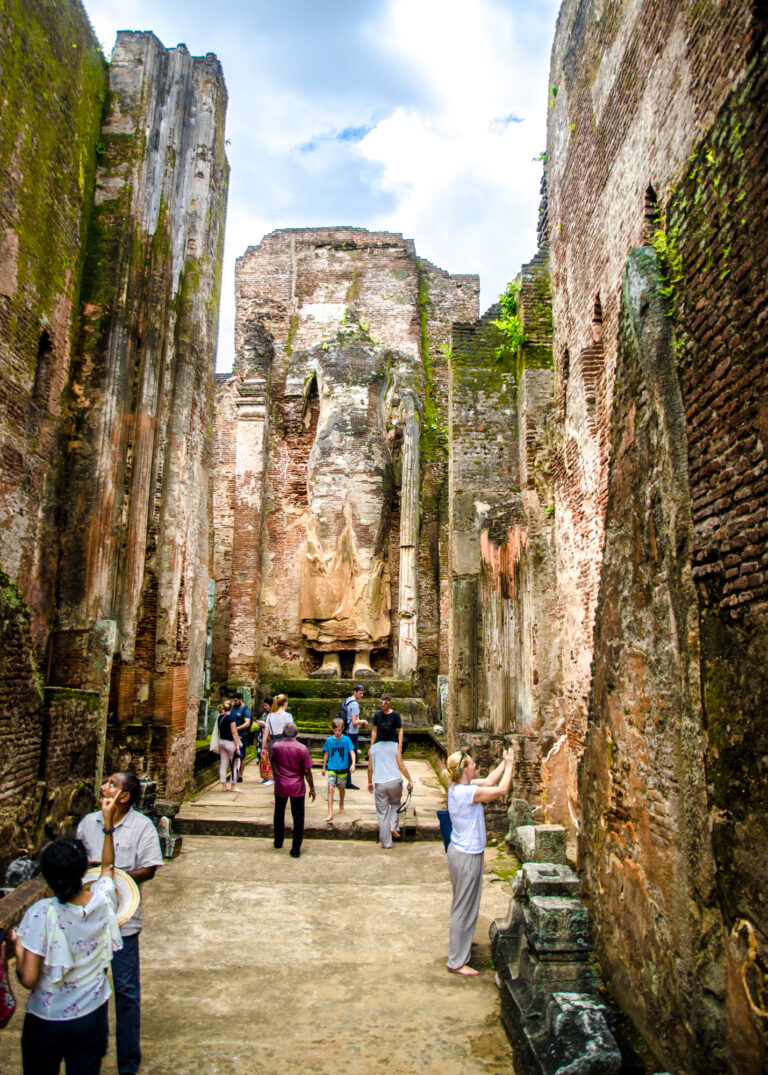
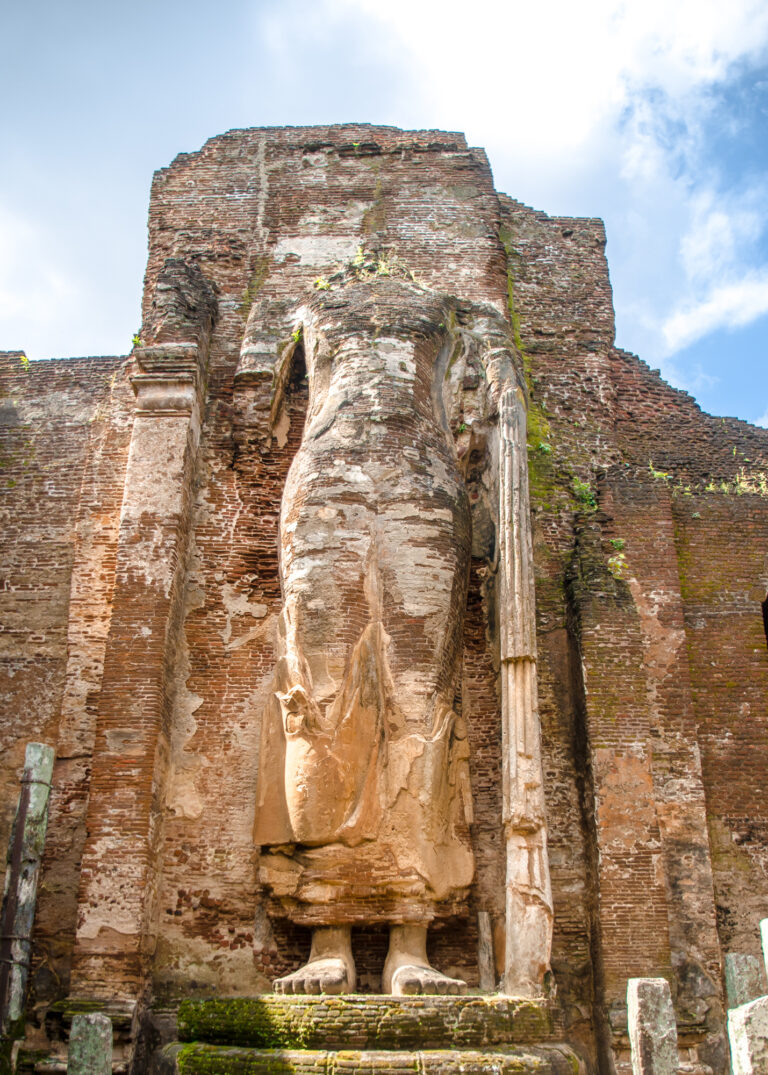
Shiva Devele II
The Hindu shrine of Shiva Devele II is believed to be the oldest building in the entire city which makes it a very important stop to make.
Unlike many of the buildings of the ancient city of Polonnaruwa, Shiva Devele II was created entirely by stone and so is rather unique. Due to this reason, the structure remains in a similar condition as to when it was built centuries ago.
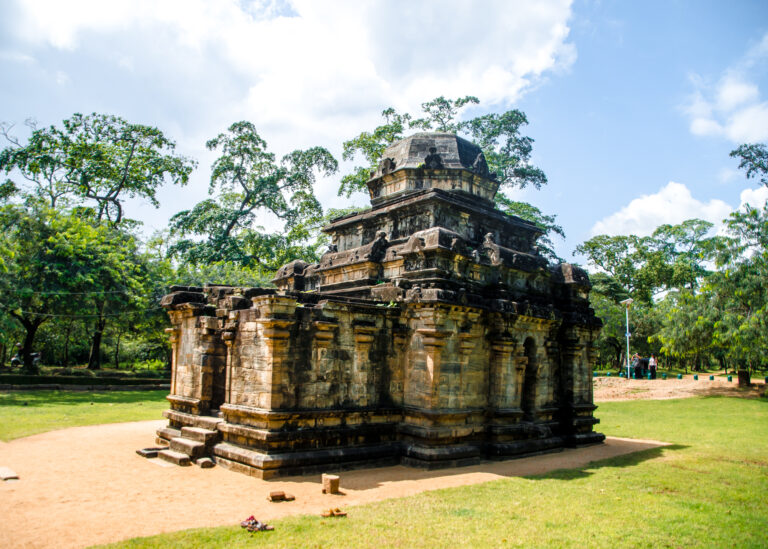
Pabalu Vehera
Pabalu Vehera is the third largest stupa in Polonnaruwa and remains in fantastic condition.
Known also as the ‘Temple of Marbles’ because small glass beads were found during excavation, the top part of the stupa was destroyed by invaders giving it a slightly odd, rounded appearance. Despite its heavy state of ruin and lack of maintenance, Pabalu Vehera is certainly worthy of a quick stop during the day.
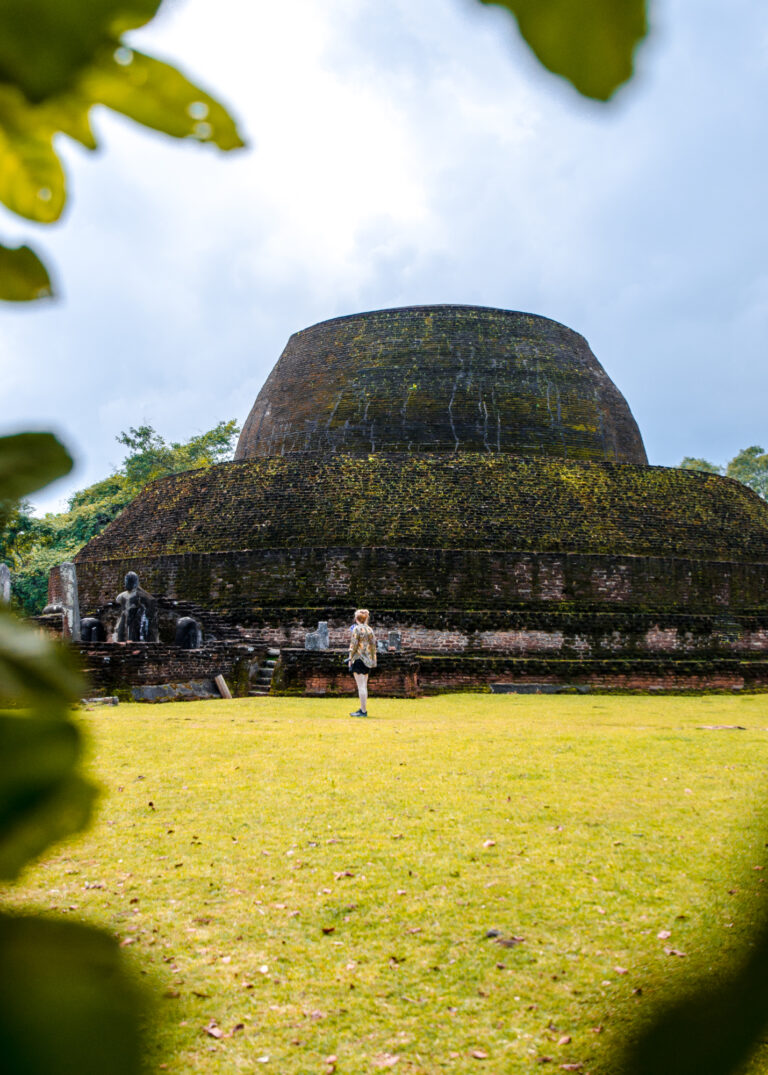
Dagaba Kiri Vihara
My personal favourite place in Polonnaruwa is Dagaba Kiri Vihara, meaning ‘milk white stupa’.
This large and stunning stupa claims the number one spot for the best preserved unrestored stupa in the whole city and is found north of Lankathilaka. It was erected by a queen of King Parakramabahu and was rediscovered when archaeologists uncovered it in perfect condition after around 700 years hidden and forgotten.
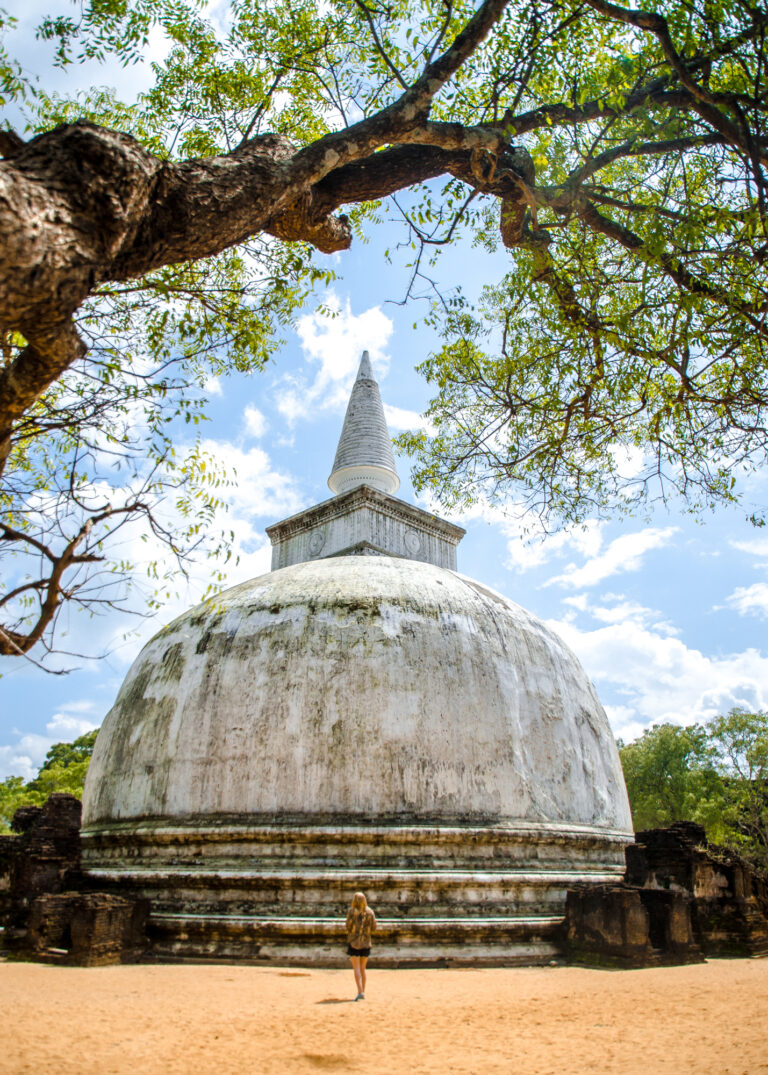
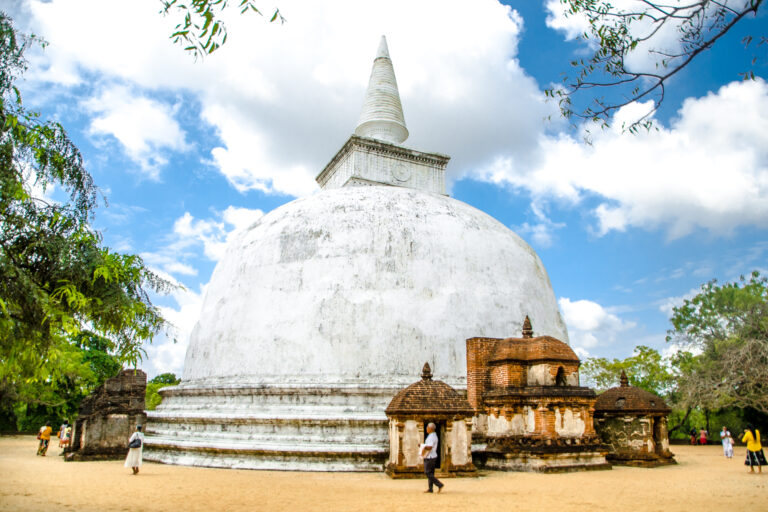
Gal Vihara
Gal Vihara, literally meaning ‘Rock Monastery’, is a popular site consisting of four images of Buddha, famously depicting the four stages of his life: sitting, standing, walking and reclining.
The reclining Buddha sculpture is 14m long, representing Buddha entering the Nirvana stage, and is the most notable of these 12th century granite rock carvings.
More photos around Polonnaruwa
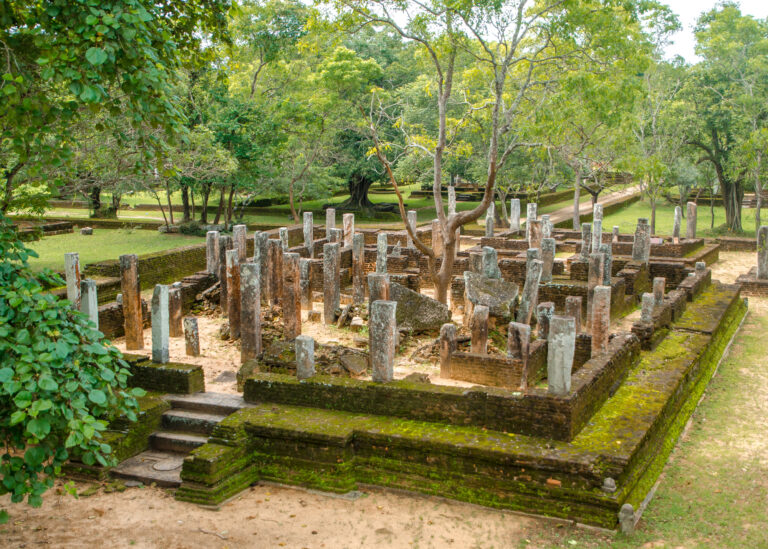
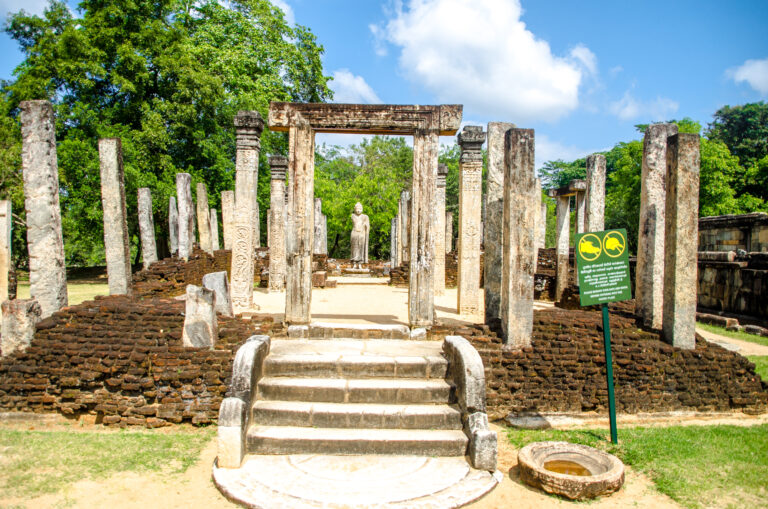
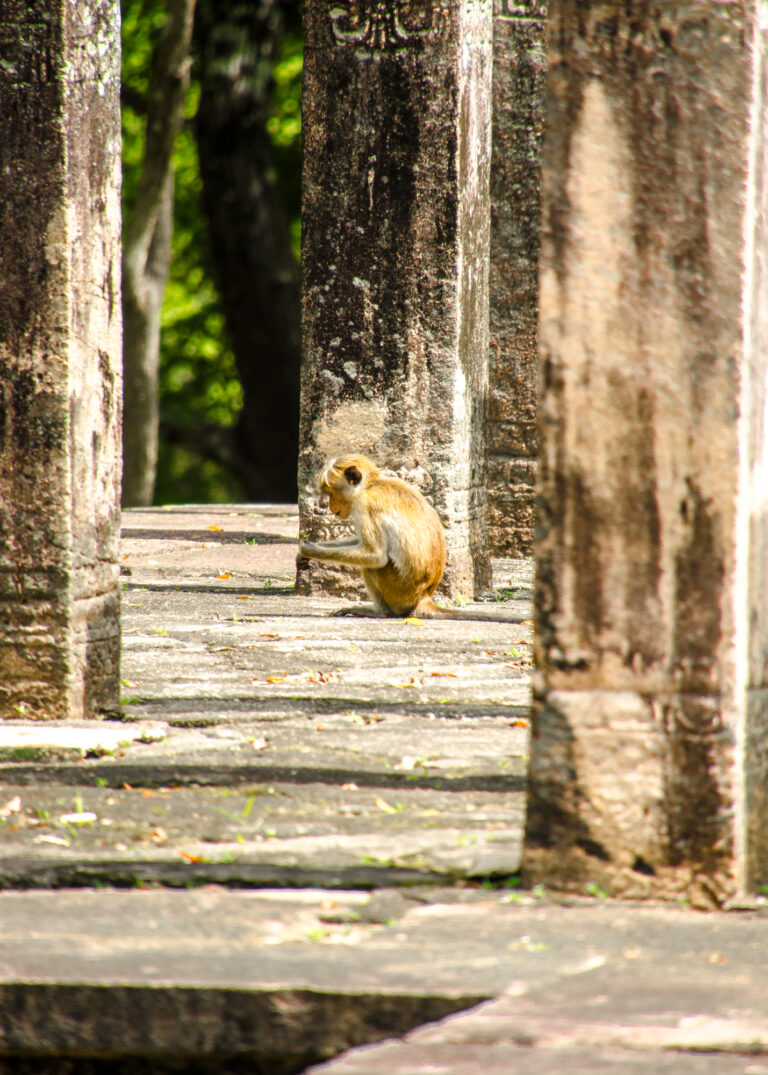
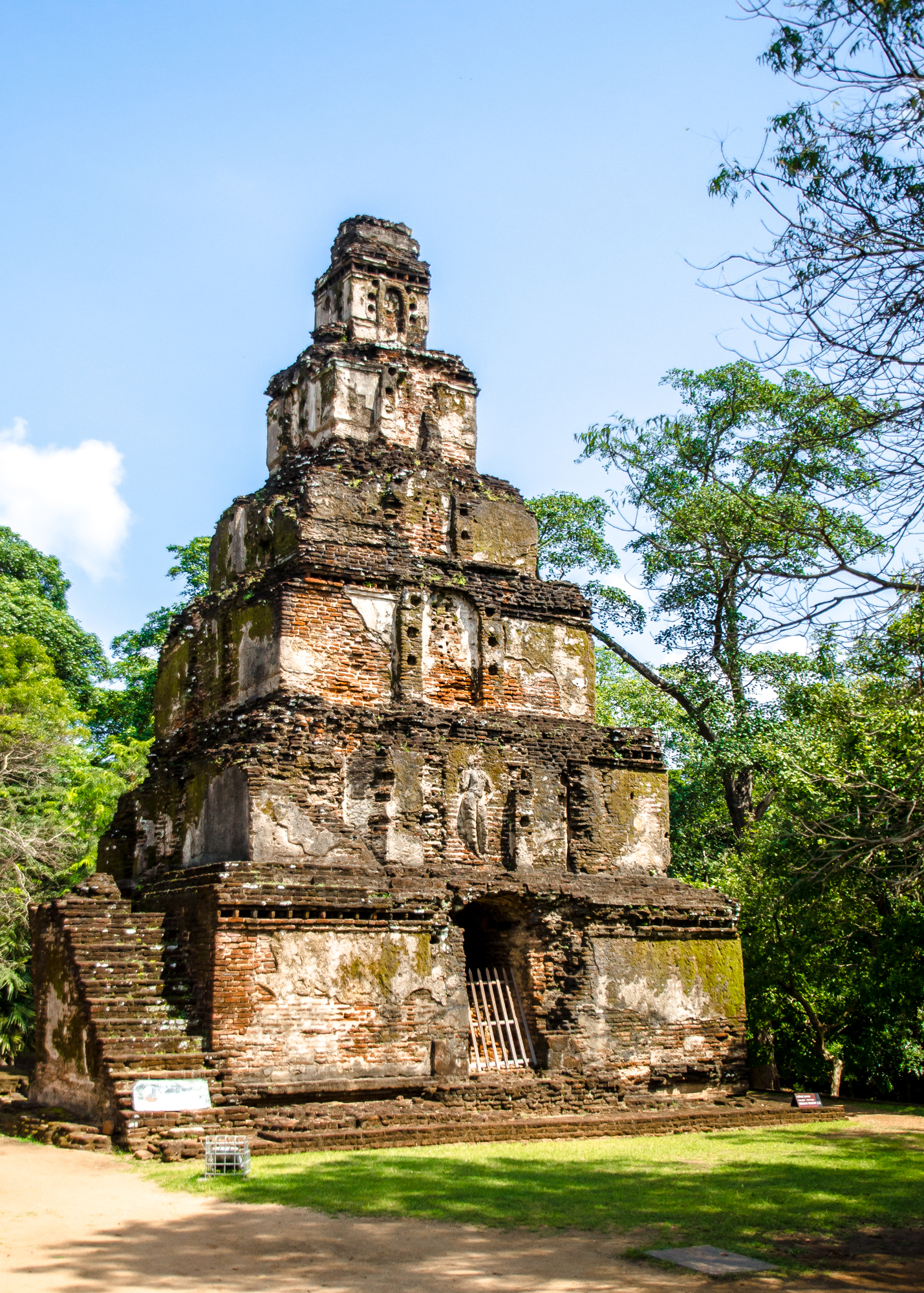
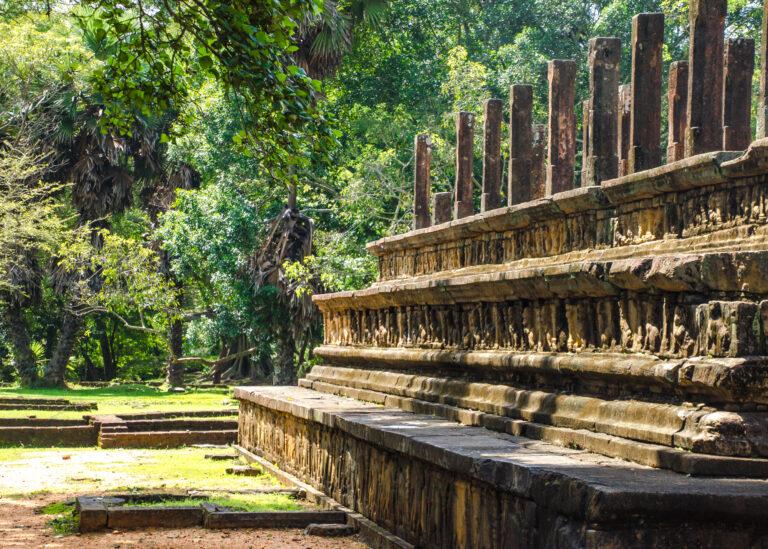
My experience at Polonnaruwa
As a traveller who loves visiting historic places, I have a real thing for ancient cities like this.
They’re packed with culture and give you a feel for what a country or place used to be like and where its roots are. For me, you can’t really come to Sri Lanka and not visit one of its former capitals, just like you can’t go to Cambodia and not visit Angkor Wat, Myanmar and not visit Bagan or Thailand and not visit Ayutthuya. They have such significance and so many interesting stories to tell that most people in our world will never get the chance to know.
Polonnaruwa was a cool addition to my 2 week Sri Lankan adventure in early 2020 and I’m super glad I visited. Admittedly, I didn’t know anything about it beforehand and I’m slightly gutted I didn’t take more pictures, but it was the perfect way to spend half a day while on the way south. Even though visiting the city was somewhat of a spontaneous decision, it’s one that I’m very happy I made!
Where to stay
There are loads of affordable, clean and friendly places to stay in Polonnaruwa that allow you to be in close proximity to the ancient city.
Find somewhere that suits your budget on Booking.com or Hostelworld or use the box below to make a quick search.
Best tours of Polonnaruwa

Thank you for reading this travel guide – I hope you found it helpful! Feel free to leave a comment below if you have any questions and I’ll get back to you as soon as possible
Happy travelling!
HELPFUL RESOURCES FOR PLANNING YOUR TRIP
Accommodation: Booking.com, Hostelworld
Tours: GetYourGuide, Viator, Klook, TripAdvisor
Transport: 12Go, Omio, Trip.com, Rome2Rio
WHO IN THE WORLD IS JAMES?
Click below to learn more about my story, including 5 random facts about me, some travel FAQ’s and my entire travel history.

